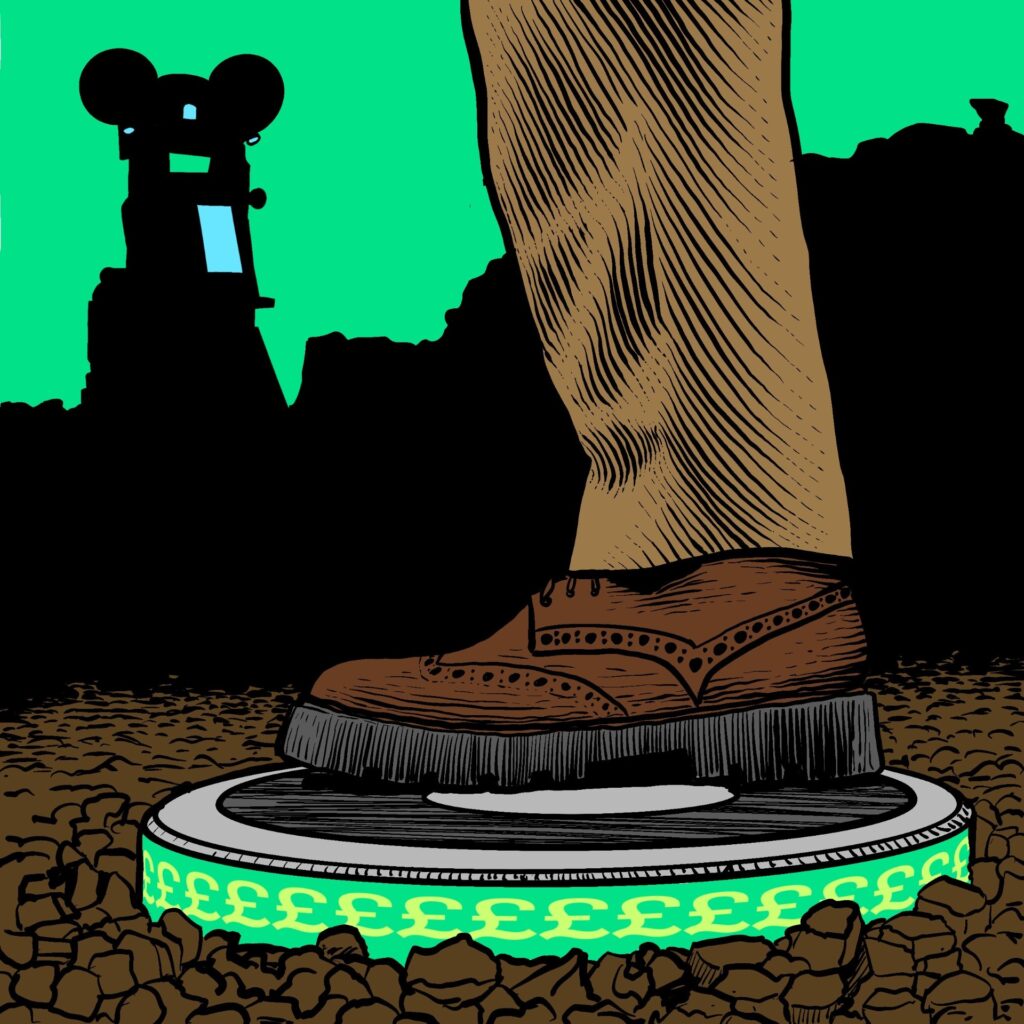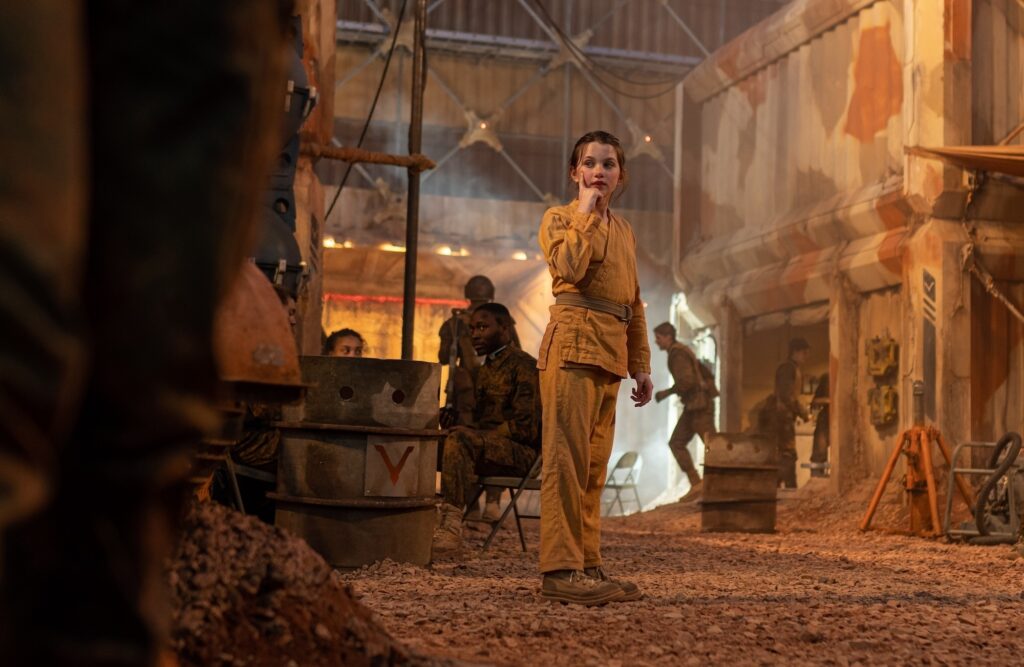Reviewed by Tim Robins
Caught in the middle of a devastating war on Kastarion 3, the Doctor is trapped when he steps on a landmine. Can he save himself and Ruby, plus the entire planet… without moving?

Doctor Who has returned to TV with a bang, even if the actual viewing figures make it look like a whimper. But it has at least been getting enough viewers to place it among the top five most watched programmes on a Saturday night.
On the figures for Saturday alone, Boom, the third episode in the latest series, however you count them, is ranked fourth most watched show on all channels. Meanwhile, although Disney Plus have not released actual viewing figures, they have announced that Doctor Who is ranked seventh among all their shows in America and has been placed among the Top 10 in around 60 other countries. Hurrah for that!



However, I still don’t don’t see Disney’s money on the screen. Apart from the huge TARDIS console room set, there’s not much difference from Chris Chibnall’s preceding seasons. During Chibnall’s seasons, you could see the show was struggling to afford 4K standard sets, but even now, for me, Doctor Who doesn’t have the scope of American SF series (although it has considerably more interesting stories).
Boom did use the “volume” technology to provide a magnificent sky-scape of alien planets. But we were again denied the pleasure of actually seeing the TARDIS materialise on the planet’s surface. It’s a strange quirk of the last decade, as if the materialisation effect is too time consuming or too hokey and yet, for me, it captures the essence of the show’s appeal.
Inded, Boom had the feel of a Star Trek “bottle show”. Instead of being set entirely in the TARDIS, it was mostly set in a crater, where the Doctor had accidentally stepped on a robotic landmine. One false move, and the Doctor would be turned into a bomb capable of blowing up the planet, that planet being Kastorian which has been turned into a battlefield in a war between the Anglican Marines and an unseen enemy believed to be sentient fog, or even sentient mud.
As the story progresses more of the cast are drawn to the crater, until the Doctor is surrounded by a handful Anglican Marines, including an AI representation of one of the dead, John Francis Vater, who is killed by an ambulance robot that makes an instant cost-benefit analysis and deems it too expensive to wait until Vater’s eyesight is restored.

Although Boom has been read as a commentary on capitalism, for us in the UK it dramatised the tensions between the NHS and Private Health care, and the dangers of making a public service a for-profit organisation.
There is a lot of creepy stuff going on in Boom, not the least of which is the way the people killed are smelted into horrible souvenirs – hardened, pink tubes where bits of their body, such as eyes, are still visible. Meanwhile, their ‘spirits’ appear as AI generated figures granted personalities that approximate the victims.

Director Julie Anne Robinson decided to shoot all the scenes in the order in which they appeared in the script. This may well have enhanced the performances of the ensemble cast who are excellent, especially young Caoilinn Springall as Splice Vater, who must face the fact that her father has been killed. The scenes of her Father’s AI explaining to his daughter that he had died were heart-breaking.
Ncuti Gatwa and Millie Gibson’s performances were tremendous. Gatwa’s Doctor has decisively broken free from the shadow David Tennant cast over the series. Gatwa is his own man. I also managed to forget the mystery box of Ruby Sunday as Gibson played the companion in a new way – caring for the Doctor and, perhaps because of that, unafraid to disobey his orders even though it endangered her own life.
Of course, there were the usual Moffatisms such as words that take on sinister meanings than originally intended. “Thoughts and Prayers”, the ambulance intones as it fries another victim; “Sharp scratch” as the ‘nurse’ impales its victim with an electronic arm. And “Kissy Kissy”, pet words exchanged between father and daughter change their import according to context. Let’s not forget that, back in the day, it was Moffat who made “Are you my Mummy?” such a popular slogan, especially amongDoctor Who’s young audience.
Moffat has described Boom as an exercise in suspense. Sometimes, he has said “tension”. I think the latter is more appropriate, because Alfred Hitchock – the ‘Master of Suspense’ – defined suspense as resulting from the audience knowing more about a situation than the characters on screen. Remember that scene in The Birds where actress Tippi Hedren as Melanie Daniels sits, smoking, in front of a school climbing frame not noticing what the audience sees – that more and more birds are gathering on the frame behind her? Daniels’ burning cigarette marks the passage of time as the audience awaits the inevitable moment that she’ll turn and see the birds and they will attack. Now that is suspense.
I resented Moffat’s comments that Doctor Who rarely does suspense. In your memory maybe Mr Moffat, but in mine Doctor Who used to do nothing but suspense before it became a less than 50-minute format. Still, he undoubtedly succeeded in wracking up the tension, even if the appearance of an entire troop of ambulances turned up too late to amount to anything more than a rather brief escalation of threat. Moffat can write well, although the developing relationship between the two Anglicans, Munday and ‘Canto’ seemed to be written for adolescents rather than adults.

There were a lot of continuity points for fans to spot, such as the involvement of the Anglican army and the weapons manufacturer Villengard, referenced as long ago as Eccleston’s season in 2005. Then there was the ‘surprise’ reappearance of former Brookside actress Susan Twist as the sinister face of the ambulance.
Some of the perceived continuity was unplanned. Moffat has said that The Doctor singing “The Skye Boat Song” was not a call back to the Second Doctor who played the tune in The Web of Fear. And, although Varada Sethu appears in Boom as Munday Flynn, her character is apparently unrelated to Varada’s role next season as the Doctor’s new companion.
Then there were the on-going mysteries: why and how does Ruby manifest snow at times of crisis? Some have speculated that the new season is set in a television programme. I feel it might be taking place in a snow globe, to be revealed in the Christmas Special, of course.
In terms of tone, I found Boom a jarring experience. It was as if Doctor Who had jump cut to a different season, even a different Doctor (Moffat has said that he was inspired by a scene in Genesis of The Daleks in which Tom Baker’s Doctor steps on a mine). But I also found Boom incredibly sad. For all the gimmickry, I think Boommay be one of Moffat’s most heartfelt stories.
Boom concluded with a line from Phillip Larkin’s “An Arundel Tomb”, “What will survive of us is love”. Larkin meant the line to be ironic. The poem is about a memorial to two aristocrats – The Earl of Arundel and his second wife Eleanor of Lancaster. Larkin writes, “They would not think to lie so long”. Lie is used in two senses: that the couple’s sculptured bodies lie on the tomb and this representation of steadfast love is also a lie. Interestingly, Larkin, on reflection, dismissed his poem as “too timey”, in the sense that it focuses on the way humanity’s aspirations to immortality fail even if set in stone.
Larkin is the “sad old man” the Doctor refers to at the end of the episode. Larkin had a fear of death as does Moffatt. Boom, a trivial, ticksy title, sees the author confront death and, within the secular genre of SF, recognise a role for spirituality. The Doctor’s words to the bereaved Splice are key:
“You keep the Faith, Splice”
“I thought you didn’t like Faith much, Doctor.”
“Just because I don’t like it, doesn’t mean I don’t need it”.
These words, contrast with the rebuke delivered by Jon Pertwee on the record Who Is The Doctor ‘Do you put Faith before Mind?’. No, no Doctor, we are all good atheists here, honest.
Boom is the first time Doctor Who has really confronted death on a human scale. Perhaps that’s why I find it so disturbing. I think Boom also marks a mature acceptance of death on the part of Moffat. And it extends that possibility to the audience.
Tim Robbins
Doctor Who in all its many iterations is available on BBC iPlayer
• In Review: Doctor Who – Space Babies, and The Devil’s Chord
Dear reader, a review is an opinion. Other opinions are available, including yours
A freelance journalist and Doctor Who fanzine editor since 1978, Tim Robins has written on comics, films, books and TV programmes for a wide range of publications including Starburst, Interzone, Primetime and TV Guide.
His brief flirtation with comics includes ghost inking a 2000AD strip and co-writing a Doctor Who strip with Mike Collins. Since 1990 he worked at the University of Glamorgan where he was a Senior Lecturer in Cultural and Media Studies and the social sciences. Academically, he has published on the animation industry in Wales and approaches to social memory. He claims to be a card carrying member of the Politically Correct, a secret cadre bent on ruling the entire world and all human thought.
Categories: Doctor Who, Features, Other Worlds, Reviews, Science Fiction, Television
 In Review: Doctor Who – The Legend of Ruby Sunday/ The Empire of Death
In Review: Doctor Who – The Legend of Ruby Sunday/ The Empire of Death  In Review: Doctor Who – Rogue
In Review: Doctor Who – Rogue  In Review: Doctor Who – 73 Yards
In Review: Doctor Who – 73 Yards  In Review: Doctor Who – Space Babies, and The Devil’s Chord
In Review: Doctor Who – Space Babies, and The Devil’s Chord
Doctor steps on electronic landmine and doesn’t immediately use Sonic Screwdriver to switch it off.
Just me?
Surely it’s about time the sonic screwdriver wasn’t used like a Get Out of Jail Free card?
John,
I agree, the Sonic Screwdriver has become something of an overused deus ex machina. But since it’s the Doctor’s established go-to in any situation, I really felt we needed some reason why he didn’t use it.
Unless … maybe he’s not the Doctor?
(P.S. Apologies if this posts twice. Website glitched out on me!)